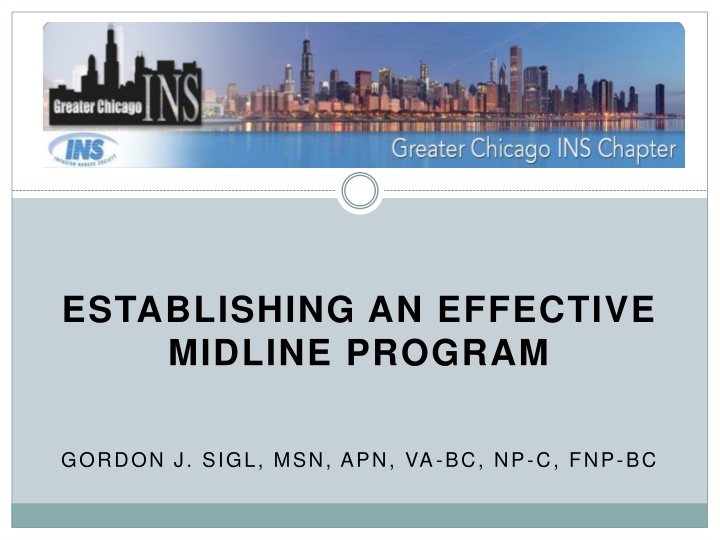
Effective Midline Program for Improved Patient Outcomes
Learn how to establish an effective midline program to reduce Central Line Associated Blood Stream Infections (CLABSI), improve patient satisfaction, and optimize clinical outcomes. Discover the advantages of midline catheters and how to select the right devices for optimal performance. Cultivate a culture change within your healthcare team to drive better vascular access practices and enhance patient care.
Download Presentation

Please find below an Image/Link to download the presentation.
The content on the website is provided AS IS for your information and personal use only. It may not be sold, licensed, or shared on other websites without obtaining consent from the author. If you encounter any issues during the download, it is possible that the publisher has removed the file from their server.
You are allowed to download the files provided on this website for personal or commercial use, subject to the condition that they are used lawfully. All files are the property of their respective owners.
The content on the website is provided AS IS for your information and personal use only. It may not be sold, licensed, or shared on other websites without obtaining consent from the author.
E N D
Presentation Transcript
ESTABLISHING AN EFFECTIVE MIDLINE PROGRAM GORDON J. SIGL, MSN, APN, VA-BC, NP-C, FNP-BC
Financial Disclosures 1. Disclosure of Relevant Financial Relationships I have the following financial relationships to disclose: Speaker s Bureau for: Access Scientific 2. Disclosure of Off-Label and/or investigative Uses I will not discuss off label use and/or investigational use in my presentation
Establishing the Need A Multi-Front Approach Central Line Associated Blood Stream Infections (CLABSI) Impact on the patient - Mortality rate 12 25%1 Impact on the organization - Publicly reported data - CMS Never Event Associated costs not reimbursable $16,550 cost to the organization/CLABSI2 o Impact on efficiency Time to insert Cost of supplies o
The Midline Advantage Multiple Objectives o Follows CDC guideline for Central Venous Catheter (CVC) avoidance3 Reduction in Central Line Associated Blood Stream Infections (CLABSI) - Improved clinical outcomes - Significant cost avoidance in value-based purchasing reimbursement model o Provides timely insertion for patients with difficult intravenous access (DIVA). Improved time to therapy o Provides extended dwell resulting in less patient sticks and therefore less pain Improved patient satisfaction
Device Selection Using keen critical thinking skills o Blood Flow impacts dilution Lower arm: 20-40mL/Minute Upper arm: 100-150mL/Minute4 o Size of vessel vs. size of midline catheter Does the tail wag the dog ? - Don t let brand loyalty cloud your judgment o Is there a one device solution? Vessel Size + Vessel Depth = Midline Device Selection
Putting it all together Culture Change o Driven by the Vascular Access Team o Establish yourself as the specialist o Education o Certification o VA-BC o Collaboration Bedside nurses Providers Patients
Putting it all together Subject Matter Experts o Utilize teachable moments Coaching others - Builds confidence in your message - Lead by example - Share your knowledge - Nursing grand rounds - Competency Fair o Identify ideal patients Central line avoidance or removal prior to CLABSI Extended stay patients (beyond 6 days)
Putting it all together Broadcast your successes o Staff meetings o Safety Huddles o With individuals o Get published o Speak locally and nationally
Cement the change Policy development o Midline as a peripheral IV Inserter s discretion No provider order Stock an appropriate range of devices o Formalize patient selection
Device selection Does patient require? Yes No Vasopressors CVP Monitoring TPN (Central Venous Concentration) Chemotherapy (Central Infusion Required) IV Antibiotic Therapy Lasting > 3 weeks Infusion of Drug Requiring Central Venous Administration (Per Pharmacy Recommendation) Yes NO Does patient have positive blood cultures or clinical signs of sepsis? Is Central Venous Access absolutely necessary at this time? Recommend PIV (if anticipated therapy </= 4 days) or Midline placement (> 4 days). No Yes Recommend PICC only if long term therapy is anticipated and place if ordered. MD to place TLC for short term therapy (ie; vasopressors) (AVOID FEMORAL ACCESS!). Monitor insertion site dressing compliance daily. Monitor for continued need daily. Replace with PIV and/or Midline as soon as clinically feasible.
Outcomes PICC & MIDLINE TRENDS 100 90 80 NUMBER OF INSERTIONS 70 60 PICC INSERTIONS 50 MIDLINE INSERTION 40 Linear (PICC INSERTIONS) 30 Linear (MIDLINE INSERTION) 20 10 0 MONTH/YEAR
Outcomes Utilization Ratio (Device Days/Patient Days) 0.60 0.50 0.40 ICU CL Utilzization Ratio 0.30 M/S & SD Utilization Ratio 0.20 0.10 0.00 Mar May Mar May Jul Sep Nov Jul Sep Nov Jul Sep Jan '11 Jan '12 Jan '13 Jan '14 Mar Mar Sep May May Jul Nov
References 1Centers for Disease Control and Prevention. (2011, March 1). Morbidity and Mortality Weekly Report. 60. Atlanta, GA, USA. Retrieved August 15, 2015, from http://www.cdc.gov/mmwr/pdf/wk/mm60e0301.pdf 2The Joint Commission. Preventing Central Line Associated Bloodstream Infections: A Global Challenge, a Global Perspective. Oak Brook, IL: Joint Commission Resources, May 2012. http://www.PreventingCLABSIs.pdf. 3O Grady N, Alexander M, Burns L, et al. Guidelines for the Prevention of Intravascular Catheter-Related Infections, 2011. Centers for Disease Control. 2011:1-83. 4Anderson N. Midline Catheters: The middle ground of intravenous therapy administration. J Infus Nurs. 2004; 27(5): 313-321.
